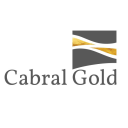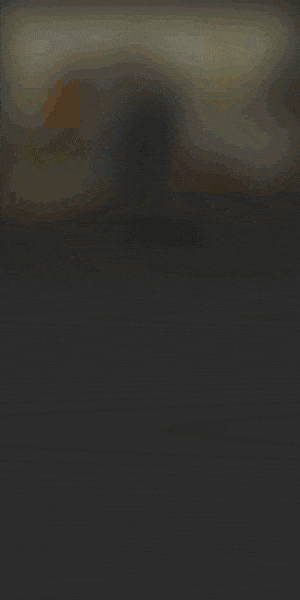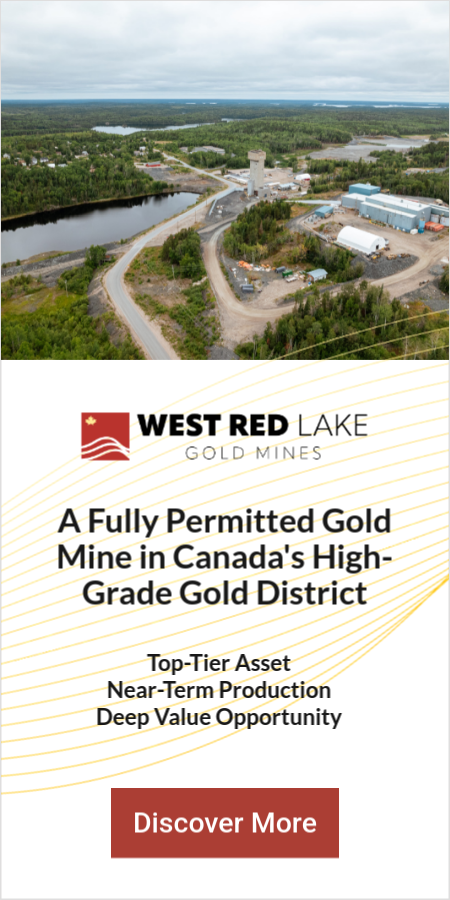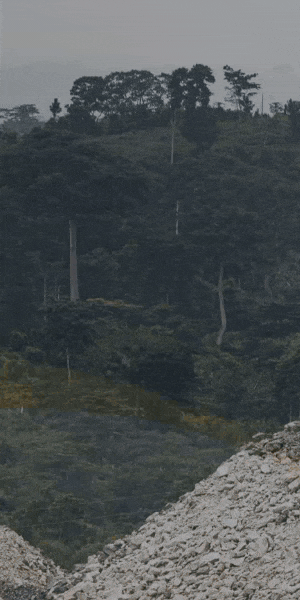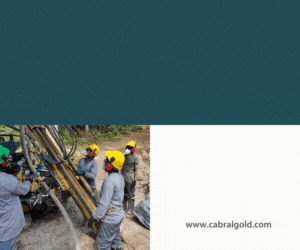Cabral Gold: High-Grade PDM Discovery Positions Junior for Rare Production Launch Amid $4,000/oz Gold Surge

Cabral Gold's 23m @ 4.7 g/t drill hit at PDM strengthens oxide starter economics with 139% IRR at $3,340/oz as gold forecasts breach $4,000/oz for 2026.
- Cabral Gold reported high-grade drilling at PDM Target (23 m @ 4.7 g/t Au, including 5 m @ 12.1 g/t Au) extending mineralization 150 m northwest and confirming district-scale continuity across Brazil's Cuiú Cuiú project.
- The July 2025 pre-feasibility study projects an oxide starter operation delivering 113,000 oz over 6.2 years with 78% after-tax IRR at $2,500/oz and 139% IRR at spot gold of $3,340/oz.
- Reuters polling of 39 analysts forecasts gold averaging $3,400/oz in 2025 and $4,275/oz in 2026, marking the first consensus breach of $4,000/oz driven by central bank buying and geopolitical uncertainty.
- Current resources total approximately 1.19 Moz across indicated and inferred categories with over 45 untested regional targets including surface grades exceeding 50 g/t Au at Alonso, Mutum, and Tracajá.
- Management targets a construction decision in Q3 2025 with first gold production in H2 2026, positioning the company to self-fund expansion through early cash flow and reduce equity dilution.
Introduction: Rare Production Timeline Meets Historic Gold Rally
Cabral Gold Inc. has emerged as one of the few junior exploration companies advancing toward near-term production during gold's strongest rally since the 1979 oil crisis. The October 28, 2025 drill results from the PDM Target, returning 23 m @ 4.7 g/t Au including 5 m @ 12.1 g/t Au, arrive as Reuters polling shows analyst consensus for 2026 gold prices crossing $4,000/oz for the first time, with a median forecast of $4,275/oz. This convergence of high-grade exploration success and structural gold demand creates a compelling entry point for investors seeking operational leverage in a proven gold district.
The company's Cuiú Cuiú project in northern Brazil occupies the same Tapajós Province that yielded approximately 30 Moz during Brazil's largest historical gold rush and continues to host active mining operations. With a construction decision targeted for Q3 2025 and first production in H2 2026, Cabral represents a rare near-term production story in the junior gold sector. The updated pre-feasibility study from July 2025 demonstrates that every $100/oz increase in gold price adds approximately $10 M to project net present value, positioning the asset to capture upside from the forecast price environment.
Current market conditions reflect a fundamental shift in gold's role within institutional portfolios. Gold has surged 54% in 2025, with the year-to-date average reaching $3,281/oz. Analysts surveyed by Reuters cite geopolitical uncertainty, central bank reserve diversification, and expectations of interest-rate cuts as structural rather than cyclical drivers, supporting gold's transition from speculative asset to core portfolio holding. For mining companies with proven resources and near-term production timelines, this environment offers both valuation support and operational margin expansion.
Company Overview: District-Scale System in Proven Gold Province
Cabral Gold controls the Cuiú Cuiú Gold District within the Tapajós Province of Pará State, Brazil, a jurisdiction that produced over 2 Moz of placer gold from Cuiú Cuiú alone and continues to attract major mining investment. The district encompasses a 15 × 10 km corridor hosting two defined deposits (Central and MG) and four recent hard-rock discoveries including PDM, Machichie Main, Machichie NE, and Jerimum Cima. Over 45 additional targets remain untested across the property, with surface sampling at Alonso returning quartz-vein boulder grades ranging from 11.6 to 200 g/t Au.
The current mineral resource inventory totals approximately 1.19 Moz across indicated and inferred categories. Indicated resources comprise 12.29 Mt @ 1.14 g/t Au (450,000 oz primary) and 13.56 Mt @ 0.50 g/t Au (216,000 oz oxide), while inferred resources include 13.63 Mt @ 1.04 g/t Au (455,000 oz primary) and 6.40 Mt @ 0.34 g/t Au (71,000 oz oxide). The resource base supports a 6.2-year mine plan under the July 2025 pre-feasibility study, with expansion potential from ongoing exploration at PDM, Machichie, and regional targets.
Management's development strategy prioritizes a low-capital oxide starter operation to generate early cash flow for district expansion. The heap-leach processing approach requires no crushing or grinding infrastructure, with capital expenditure estimated at $37.7 M and a 10-month payback period at $2,500/oz gold. This model aligns with juniors that have successfully transitioned to production in similar jurisdictions, providing a blueprint for self-funded growth without significant equity dilution during the construction phase.
Key Development: PDM Discovery Extends High-Grade Continuity
The October 28, 2025 drill results from PDM Target delivered 23 m @ 4.7 g/t Au including 5 m @ 12.1 g/t Au and 1 m @ 40.3 g/t Au, extending mineralization 150 m northwest of previous intercepts reported in Q2 2025 (22 m @ 4.8 g/t Au and 18 m @ 2.5 g/t Au). The new hole confirms structural continuity between the oxide blanket and underlying primary zone, suggesting a feeder system that may link toward the Central deposit. Mineralization remains open along strike and at depth, warranting infill and step-out drilling to define resource expansion potential.
Alan Carter, President and CEO of Cabral Gold:
"The results from diamond drill hole DDH346 at the PDM target at Cuiú Cuiú highlight the presence of several very high-grade structures in the intrusive rocks below the gold-in-oxide blanket at PDM. These four discrete structures remain open along strike and down-dip. Whilst a significantly larger gold-in-oxide blanket occurs at PDM than previously envisaged, there is increasing evidence of down-dip and along strike continuity of the four known zones of primary mineralization within the intrusive rocks below the gold-in-oxide blanket."
Geological interpretation indicates that PDM represents a parallel high-grade vein system within the broader district-scale mineralizing corridor along the Tocantinzinho lineament. The presence of stacked oxide and primary zones at consistent grades across multiple drill holes supports the potential for a materially larger resource envelope than currently modeled. Independent analysts note that continuity of such grades, particularly the 12.1 g/t Au and 40.3 g/t Au intervals, could significantly enhance project economics by improving mill feed grades during later-stage primary processing.
The timing of the PDM results strengthens the investment case ahead of the anticipated Q3 2025 construction decision. While the July 2025 pre-feasibility study was based on existing resources, the PDM drilling demonstrates organic growth potential that could extend mine life beyond the initial 6.2-year plan. Each additional high-grade ounce discovered at shallow depths improves the project's leverage to rising gold prices, as oxide material requires minimal processing capital and delivers rapid payback on exploration investment.
Strategic Significance: Production Leverage in $4,000/oz Environment
The convergence of Cabral's production timeline with gold's structural price re-rating creates exceptional operational leverage. At the current spot price of $3,340/oz, the oxide starter operation generates an after-tax IRR of 139% and NPV₅ of $138 M according to the July 2025 pre-feasibility study. Under the Reuters consensus forecast of $4,275/oz for 2026, the year of planned production launch, project economics would improve substantially beyond the already robust base case, with each $100/oz increase adding approximately $10 M to net present value.
The forecast gold price environment reflects structural rather than cyclical demand drivers. Central bank buying reached record levels in 2024 and 2025, while exchange-traded fund inflows have resumed after two years of outflows. Interest-rate cut expectations reduce the opportunity cost of holding non-yielding gold, and geopolitical uncertainty supports safe-haven demand. These factors have driven gold's 54% gain in 2025, the strongest annual performance since the 1979 oil crisis, and underpin analyst confidence that $4,000/oz represents a sustainable baseline rather than a speculative peak.
For junior miners with proven resources and near-term production, this macro backdrop provides valuation support at multiple stages of the development cycle. Projects that demonstrate robust economics at conservative gold prices ($2,500-3,000/oz) benefit from substantial upside optionality as forecasts rise, while companies can secure project financing and off-take agreements on favorable terms. Cabral's $37.7 M capital requirement represents a modest financing hurdle relative to typical development-stage projects, reducing execution risk and minimizing dilution during the construction phase.
Current Activities: Construction Decision & Resource Expansion
Management has targeted a construction decision in Q3 2025 following completion of permitting and project financing arrangements. The company is engaged in ongoing discussions regarding off-take agreements and debt financing to complement internal cash resources and minimize equity dilution. First gold production remains on schedule for H2 2026, positioning the oxide operation to capture the forecast $4,275/oz average gold price for that year. The simple heap-leach processing design allows for rapid construction and commissioning compared to conventional milling operations.
Carter noted that:
"These drill results come soon after last weeks announcement of the US$45 million construction financing for the Phase 1 operation at Cuiú Cuiú which is aimed at the heap leach processing of the near surface gold-in-oxide material at the MG, Machichie Main and Central gold deposits at Cuiú Cuiú."
Exploration programs continue across the district with multiple objectives. At Machichie NE, recent drilling returned high-grade intercepts including 11 m @ 33 g/t Au and 12 m @ 27.7 g/t Au, with programs underway to test down-dip extensions. The Central and MG deposits remain open for expansion with limited additional drilling required to convert inferred resources to indicated categories. Jerimum Cima, a new oxide discovery incorporated into the 2025 pre-feasibility study, continues to advance through resource definition drilling.
Regional target generation has identified over 45 untested prospects across the 15 × 10 km district corridor. The Alonso target has returned surface quartz-vein boulder samples grading 11.6 to 200 g/t Au, with the primary source yet to be identified. Mutum and Tracajá targets exhibit similar surface grades exceeding 50 g/t Au. This extensive target pipeline provides organic growth potential to extend mine life beyond the initial 6.2-year oxide phase and supports the transition to primary ore processing following completion of the starter operation.
The Investment Thesis for Cabral Gold
- Construction decision Q3 2025 and first gold H2 2026 positions asset to capture forecast $4,275/oz average, delivering 139% IRR at current spot prices.
- Over 45 untested targets with surface grades exceeding 50 g/t Au provide organic growth to extend 6.2-year mine plan without acquisition premium.
- $37.7 M capex with 10-month payback reduces financing risk and limits dilution compared to typical $100M+ development projects in junior sector.
- Central bank buying and safe-haven flows support $4,000/oz+ baseline rather than speculative peak, providing sustained margin expansion through production phase.
- Tapajós Province hosts multiple active operations with 30 Moz historical production, demonstrating permitting pathway and operational feasibility in Brazil's northern mining corridor.
- Oxide cash flow targets expansion into primary resources and regional discoveries, reducing reliance on equity markets during volatile commodity cycles.
Cabral Gold represents one of the few junior exploration companies advancing toward production during a period of structural gold price re-rating. The combination of high-grade PDM drilling results, robust oxide economics at forecast 2026 gold prices, and a district-scale exploration pipeline creates a compelling risk-adjusted profile for investors seeking operational leverage in the gold sector. With a construction decision targeted for Q3 2025 and first production in H2 2026, the company is positioned to capture the forecast $4,275/oz average gold price during its initial production year.
The project's low capital intensity and rapid payback period distinguish it from typical junior development stories, while the extensive untested target inventory provides organic growth potential beyond the initial 6.2-year mine plan. Management's strategy to self-fund expansion through oxide cash flow reduces the execution risk and equity dilution that have historically challenged junior miners during the construction-to-production transition. For investors, this approach offers exposure to both near-term production cash flow and district-scale exploration upside within a proven gold province.
The macro backdrop of $4,000/oz+ gold forecasts driven by central bank buying and geopolitical uncertainty supports sustained margin expansion for producers entering the market in 2026. Each $100/oz increase in realized gold price adds approximately $10 M to Cabral's project net present value, creating substantial upside optionality as consensus forecasts continue to rise. With gold's 54% gain in 2025 marking the strongest annual performance since 1979, and structural demand drivers replacing cyclical shock responses, the investment case for near-term gold producers has strengthened materially. Cabral's advancement from exploration through construction into production during this window positions the company to deliver shareholder value across multiple stages of the development cycle.
TL;DR
Cabral Gold's latest PDM drilling confirms high-grade continuity at its Cuiú Cuiú district in Brazil's Tapajós Province, where over 2 Moz of placer gold were historically mined. With gold forecasts reaching $4,275/oz for 2026 and a robust oxide starter delivering 139% IRR at current spot prices, the company offers near-term production leverage in a jurisdiction hosting multiple active operations. Construction decision expected Q3 2025 with production launch H2 2026.
FAQs (AI-Generated)
Analyst's Notes




Subscribe to Our Channel
Stay Informed










